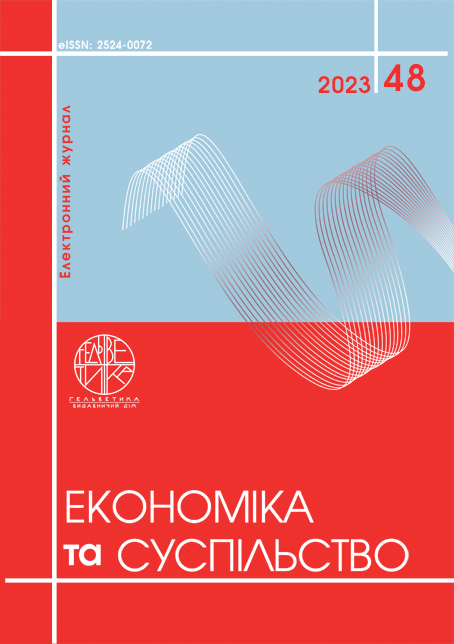МОДЕЛЬ PUSH/PULL ЯК ІНСТРУМЕНТ МАРКЕТИНГОВОГО ДОСЛІДЖЕННЯ РИНКУ ВНУТРІШНЬОГО ТУРИЗМУ
Анотація
У статті узагальнено та систематизовано можливості моделі push/pull для маркетингового дослідження ринку внутрішнього туризму в Україні. Розглянуто основні етапи формування моделей мотивації туристів, визначено чинники виштовхування та тяжіння в сфері туризму. Проаналізовано наробки закордонних дослідників з точки зору мотивації туристів, використання моделей для аналізу факторів та індикаторів мотивації, дестинації / країни та виду туризму. Виокремлено та сформовано основні переваги та недоліки використання моделі push/pull для маркетингового аналізу ринку внутрішнього туризму. Зазначено, що особливості використання цієї моделі ґрунтується на уявлені споживачів туристичних послуг на туристичні дестинації усереднені країни. Оскільки бачення міжнародних туристів зазвичай ґрунтується на погляді «ззовні», то бачення внутрішніх туристів зазвичай йде «зсередини» дестинації. Тож при використанні цього інструменту необхідно зважати на особливості суббрендів дестинацій, які існують в контексті збірного бренду.
Посилання
Dann, G. M. S. (1981). Tourist motivation an appraisal. Annals of Tourism Research, 8(2), 187–219. https://doi.org/10.1016/0160-7383(81)90082-7
Crompton, J. L. (1979). Motivations for pleasure vacation. Annals of Tourism Research, 6(4), 408–424. https://doi.org/10.1016/0160-7383(79)90004-5
Iso-Ahola, S. E. (1982). Toward a social psychological theory of tourism motivation: A rejoinder. Annals of Tourism Research, 9(2), 256–262. https://doi.org/10.1016/0160-7383(82)90049-4
Pearce, P. L., & Lee, U.-I. (2005). Developing the Travel Career Approach to Tourist Motivation. Journal of Travel Research, 43(3), 226–237. https://doi.org/10.1177/0047287504272020
Šimková, E., & Holzner, J. (2014). Motivation of Tourism Participants. Procedia – Social and Behavioral Sciences, 159, 660–664. https://doi.org/10.1016/j.sbspro.2014.12.455
Farmaki, A. (2012). An exploration of tourist motivation in rural settings: The case of Troodos, Cyprus. Tourism Management Perspectives, 2-3, 72–78. https://doi.org/10.1016/j.tmp.2012.03.007
Kulcsár, N. (2015). Consumer value dimensions of rural tourism in Hungary. Hungarian Geographical Bulletin, 64(2), 127–141. https://doi.org/10.15201/hungeobull.64.2.4
Mishra, S., Malhotra, G., Johann, M., & Tiwari, S. R. (2021). Motivations for participation in active sports tourism: a cross-national study. International Journal of Event and Festival Management, 13(1), 70–91. https://doi.org/10.1108/ijefm-06-2021-0045
Jin, X., Xiang, Y., Weber, K., & Liu, Y. (2019). Motivation and involvement in adventure tourism activities: a Chinese tourists' perspective. Asia Pacific Journal of Tourism Research, 24(11), 1066–1078. https://doi.org/10.1080/10941665.2019.1666152
Negrusa, Adina. (2012). Analysis of Cultural Tourism Motivation: The Case of Turkish Students. Scandinavian International Business Review, 11, 283.
Ceballos-Santamaría, G., Mondéjar-Jiménez, J., Sánchez-Cubo, F., & García-Pozo, A. (2021). Motivations in heritage destinations of the cultural tourist: the case of Malaga (Spain). National Accounting Review, 3(1), 86–94. https://doi.org/10.3934/nar.2021004
Sukma Winarya Prabawa, I. W., & Ratih Pertiwi, P. (2020). The Digital Nomad Tourist Motivation in Bali: Exploratory Research Based on Push and Pull Theory. Athens journal of tourism, 7(3), 161–174. https://doi.org/10.30958/ajt.7-3-3
Riley, R. W., & Van Doren, C. S. (1992). Movies as tourism promotion. Tourism Management, 13(3), 267–274. https://doi.org/10.1016/0261-5177(92)90098-r
Report on the results of the survey "Conducting a study of domestic and outbound tourism of Ukrainians". (2021, December). https://www.tourism.gov.ua/statistic
Aldoshyna, M., & Stryzhak, O. (2020). Relationship marketing in tourism. Market Infrastructure, (43). https://doi.org/10.32843/infrastruct43-20
Sushchenko, O., & Kasenkova, K. (2019). Territory branding as a tool of a tourist-recreational complex. Economic innovations, 21(2(71)), 139–149. https://doi.org/10.31520/ei.2019.21.2(71).139-149
Dann, G. M. S. (1981). Tourist motivation an appraisal. Annals of Tourism Research, 8(2), 187–219. https://doi.org/10.1016/0160-7383(81)90082-7
Crompton, J. L. (1979). Motivations for pleasure vacation. Annals of Tourism Research, 6(4), 408–424. https://doi.org/10.1016/0160-7383(79)90004-5
Iso-Ahola, S. E. (1982). Toward a social psychological theory of tourism motivation: A rejoinder. Annals of Tourism Research, 9(2), 256–262. https://doi.org/10.1016/0160-7383(82)90049-4
Pearce, P. L., & Lee, U.-I. (2005). Developing the Travel Career Approach to Tourist Motivation. Journal of Travel Research, 43(3), 226–237. https://doi.org/10.1177/0047287504272020
Šimková, E., & Holzner, J. (2014). Motivation of Tourism Participants. Procedia – Social and Behavioral Sciences, 159, 660–664. https://doi.org/10.1016/j.sbspro.2014.12.455
Farmaki, A. (2012). An exploration of tourist motivation in rural settings: The case of Troodos, Cyprus. Tourism Management Perspectives, 2-3, 72–78. https://doi.org/10.1016/j.tmp.2012.03.007
Kulcsár, N. (2015). Consumer value dimensions of rural tourism in Hungary. Hungarian Geographical Bulletin, 64(2), 127–141. https://doi.org/10.15201/hungeobull.64.2.4
Mishra, S., Malhotra, G., Johann, M., & Tiwari, S. R. (2021). Motivations for participation in active sports tourism: a cross-national study. International Journal of Event and Festival Management, 13(1), 70–91. https://doi.org/10.1108/ijefm-06-2021-0045
Jin, X., Xiang, Y., Weber, K., & Liu, Y. (2019). Motivation and involvement in adventure tourism activities: a Chinese tourists' perspective. Asia Pacific Journal of Tourism Research, 24(11), 1066–1078. https://doi.org/10.1080/10941665.2019.1666152
Negrusa, Adina. (2012). Analysis of Cultural Tourism Motivation: The Case of Turkish Students. Scandinavian International Business Review, 11, 283.
Ceballos-Santamaría, G., Mondéjar-Jiménez, J., Sánchez-Cubo, F., & García-Pozo, A. (2021). Motivations in heritage destinations of the cultural tourist: the case of Malaga (Spain). National Accounting Review, 3(1), 86–94. https://doi.org/10.3934/nar.2021004
Sukma Winarya Prabawa, I. W., & Ratih Pertiwi, P. (2020). The Digital Nomad Tourist Motivation in Bali: Exploratory Research Based on Push and Pull Theory. Athens journal of tourism, 7(3), 161–174. https://doi.org/10.30958/ajt.7-3-3
Riley, R. W., & Van Doren, C. S. (1992). Movies as tourism promotion. Tourism Management, 13(3), 267–274. https://doi.org/10.1016/0261-5177(92)90098-r
Report on the results of the survey "Conducting a study of domestic and outbound tourism of Ukrainians". (2021, December). https://www.tourism.gov.ua/statistic
Aldoshyna, M., & Stryzhak, O. (2020). Relationship marketing in tourism. Market Infrastructure, (43). https://doi.org/10.32843/infrastruct43-20
Sushchenko, O., & Kasenkova, K. (2019). Territory branding as a tool of a tourist-recreational complex. Economic innovations, 21(2(71)), 139–149. https://doi.org/10.31520/ei.2019.21.2(71).139-149


